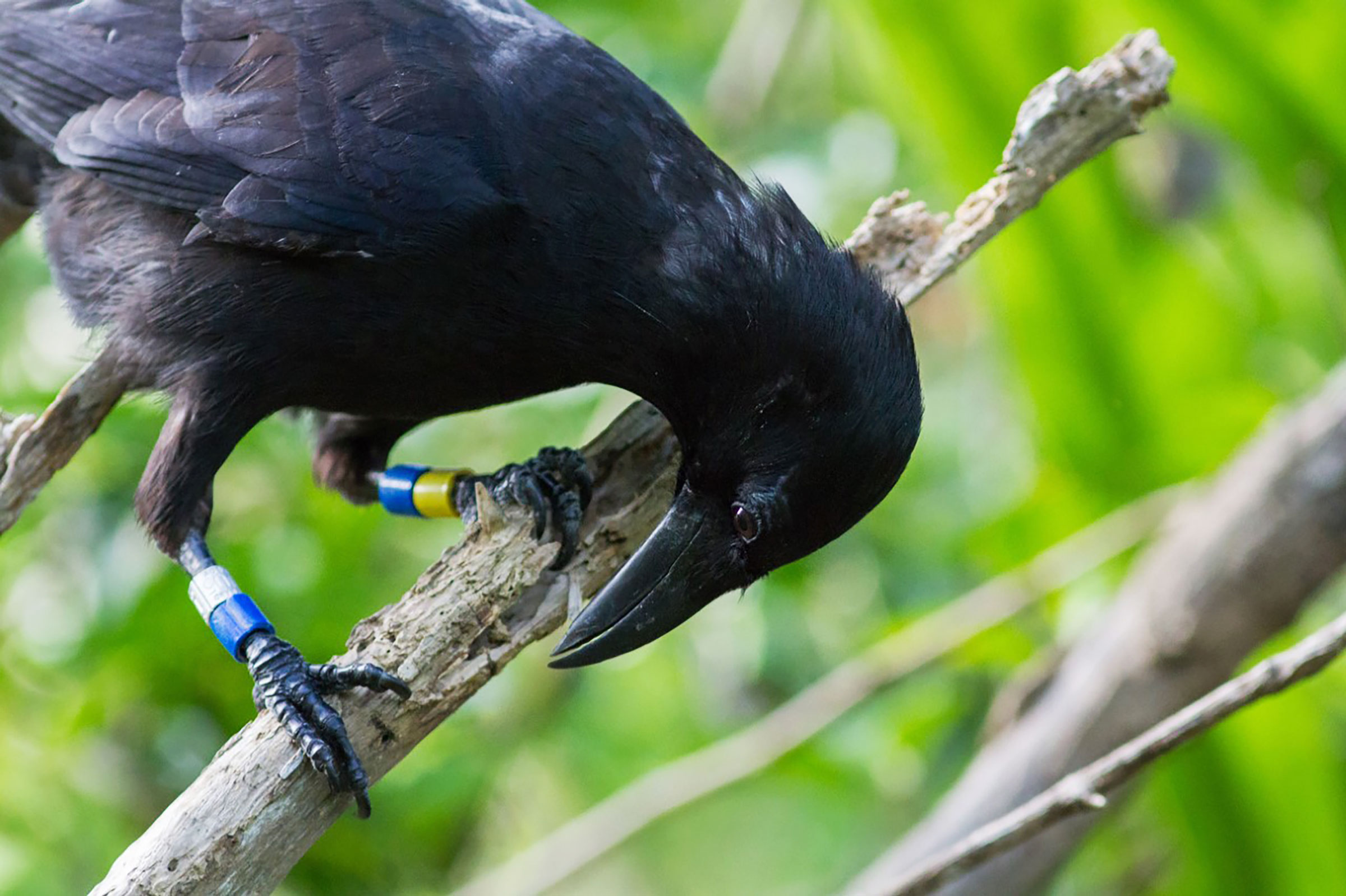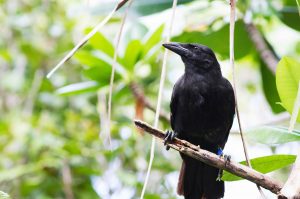TO SAVE THE MARIANA CROW:
Working with the community to bring back the åga

The Mariana crow, or åga in Chamorro, has declined over 80% since the 1980s. Now only found on Rota, the community is working to bring back its population, through the Mariana Crow Recovery Project. (HENRY FANDEL OF THE MARIANA CROW RECOVERY PROJECT)
The island of Rota has the distinction of being the only place on earth where the åga now can be found in the wild. More known as the Mariana Crow, the åga is a strong, resilient member of the genus Corvus, a family of birds which includes crows, ravens, jackdaws, and rooks.
The oldest known åga lived for at least 18 years. It is a territorial bird—fervently defending its nesting area from intruders by calling loudly, hammering its bill on branches, and even by breaking branches and tearing leaves off trees.
And, like the åga, a team of researchers, of the Mariana Crow Recovery Project, a research program administered by Dr. Renee Ha and Dr. Sarah Faegre from the University of Washington, is also passionately working to bring back the population of these extremely intelligent birds.
“The åga has been on Rota for more than two million years,” project crew leader Henry Fandel said. “It is well understood that adding or removing members from an ecological community can disrupt a balance that threatens the community or makes it more susceptible to disturbance.”
Fandel is one of 10 researchers who are on the island now, to document the trend of the åga population since 2005, to study factors contributing to the decline of the bird, to release to the wild captive-reared birds, and to conduct continuous outreach in the community and schools in Rota to ensure the success of the recovery project.
“Islands, especially small islands with their small wildlife populations, are known for hosting ecosystems that are especially prone to disturbance. Maintaining biodiversity and recovering endangered populations that are longtime members of Rota’s ecological community gives the local ecosystem it’s best chance at stability.”
“This is good for the ecosystem itself, but more importantly, it’s good for the people who depend on it.”
While, according to Fandel, they have never had a chance to officially study the ways the åga benefit Rota’s ecosystem, based on the bird’s diet and behavior, a strong åga population provides significant top-down predator control of prey communities such as insects, rats, wasps, spiders, and lizards, as well as in seed dispersal for åhgao, fagot, and tålisai trees.
Wiping out the ‘Kill the Bird’ stigma
“On Rota, [for] an individual [age] 40 and above, when you say ‘Kill the Bird,’ they know that it pertains to åga,” shared Cris Ogo, Indigenous Affairs Office program manager, in an interview with Saipan Tribune.
Ogo had a chance to go to Rota recently to conduct a forum discussing the establishment of a National Park Service unit on the island, where he met both Fandel and Faegre. Ogo, at the time, requested that the researchers present their study before the Rota Mayor’s Office, the municipal council, and dignitaries to promote a better understanding of their goal to save the bird.
According to Ogo, in the late ’90s when agricultural land permits were issued on Rota, some land permittees were told that they cannot enter the property due to encroachment of the åga habitat, where the people opposed the restriction.
The stigma still carries until today, he added, and stressed that this is why there is a need to conduct an extensive educational outreach on why the åga must be protected..
“For me and after visiting the åga holding pen, the hatchery and listening to Dr. Sarah’s presentation. I understood the need to protect the population of this endangered species. This process of touring the facilities and listening to the 45-minute presentation will definitely lower the stigma of ‘Kill the Bird.’”
“The community of Rota needs more information about the need of protecting endangered species. I think there is not enough educational awareness on this subject. Educational awareness is the missing link to better understand the åga project.”
Ogo stressed that the decline of the åga population on Rota needs to be observed to prevent further decline of the species, especially with Rota being the only island now where the bird species can be found in the wild.
The community can help
“One of the things we look forward to the most is continuing to strengthen the bonds between the research project and the community of Rota,” Fandel shared.
Throughout the project, the researchers have been working closely with, and are thankful to land owners who have given them permission to pass through their land, to get to the deeper parts of the forests where the birds can be found.
While the pandemic has affected the education and outreach initiatives regarding the åga, with visits to schools or classrooms not as easy to set up as it has been in the past, the Mariana Crow Recovery Project team has been figuring out creative ways on how they can be of service to the community.
In addition, they also welcome all aspiring wildlife biologists from the CNMI and Guam to apply for open positions on their project, which they are looking to fill between March and June 2021.
The researchers are slated to release 13 additional birds out to the wild around this time, on top of the 23 that they have already released since 2018—a serious accomplishment indeed to combat the decline, and help rebuild the åga population.
With the forest and the wildlife populations on Rota extremely valuable to the community, truly, as Fandel stressed, it is very important work to maintain the integrity of Rota’s ecosystem.
To get updates on the Åga Project, visit the Mariana Crow Recovery Project page on facebook (https://www.facebook.com/MarianaCrowRecoveryProject/).

























